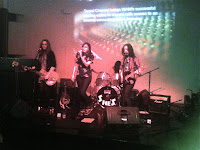THE SONG
"Back In Black" is a very typical rock song form-wise. It uses mostly arrangement techniques to develop the song rather than varying too much from the normal rock song form. It looks like this:
intro ➞ verse ➞ chorus ➞ verse ➞ chorus ➞ verse (solo) ➞
chorus ➞ bridge ➞ chorus ➞ verse (solo)
As you can see, there’s basically only two sections - a verse and chorus. The solo happens over a verse, and a different guitar line with a variation on the chord changes of a verse is used to change it into a bridge.
THE ARRANGEMENT
In their typical style, AC/DC keeps this song as pure as possible with almost no overdubs except the lead guitar. First of all, listen to the turn around between 8 bar phrases during the solos. It's still a verse, but it sounds different thanks to this slight change of bass and rhythm guitar. There's nothing added to the 2nd verse to develop it, which is unusual, but it still works great, as do the background answer vocals added to the last chorus.
Arrangement Elements
- The Foundation: bass, drums and rhythm guitars
- The Pad: none
- The Rhythm: unusual for a rock song, the vocal is in double time to the pulse of the song in the verse so it adds motion
- The Lead: lead vocal and solo guitar
- The Fills: lead guitar between the vocal lines in the verse, background vocal answers in the last chorus
THE SOUND
The sound of this record is great - big, pristine, very real and in your face, but there's a lot more going on beneath the surface than it seems. Although the record seems bone dry, the rhythm guitar has a long reverb tail that only appears on the same side (the right channel) and the lead guitar has a short double that's panned to about 1 o'clock of the rhythm guitar side.
Brian Johnson's vocal is doubled, but the second voice is not at the same level and instead just there for a bit of support. The snare has a nice room ambiance, but also has an ever so slight bit of delayed reverb added to it as well. Angus Young's solo guitar is overdubbed and placed up the middle.
Finally, check out how the guitars are actually more clean than they are distorted, a point that's lost on many a guitar player.
THE PRODUCTION
"Back In Black" is such a band oriented song that except for a few extra parts for support, what you hear on the record is exactly what you hear live. In order to pull this off, the band has to be exceptionally tight during the recording, which AC/DC certainly is.
The thing to listen for is how disciplined the band is. They play only what's necessary, with no extra ghost notes, slides or other things that you'll hear most copy bands play when doing this song. Also note the way the attacks and releases are played by the bass and two guitars. They're perfectly in sync.
Finally, listen how far behind the beat drummer Phil Rudd is, giving it that tension that the song needs to really work well at that tempo.
----------------------------------
You should follow me on Twitter for daily news and updates on production and the music business.
Don't forget to check out my Music 3.0 blog for tips and tricks on navigating social media and the new music business.


